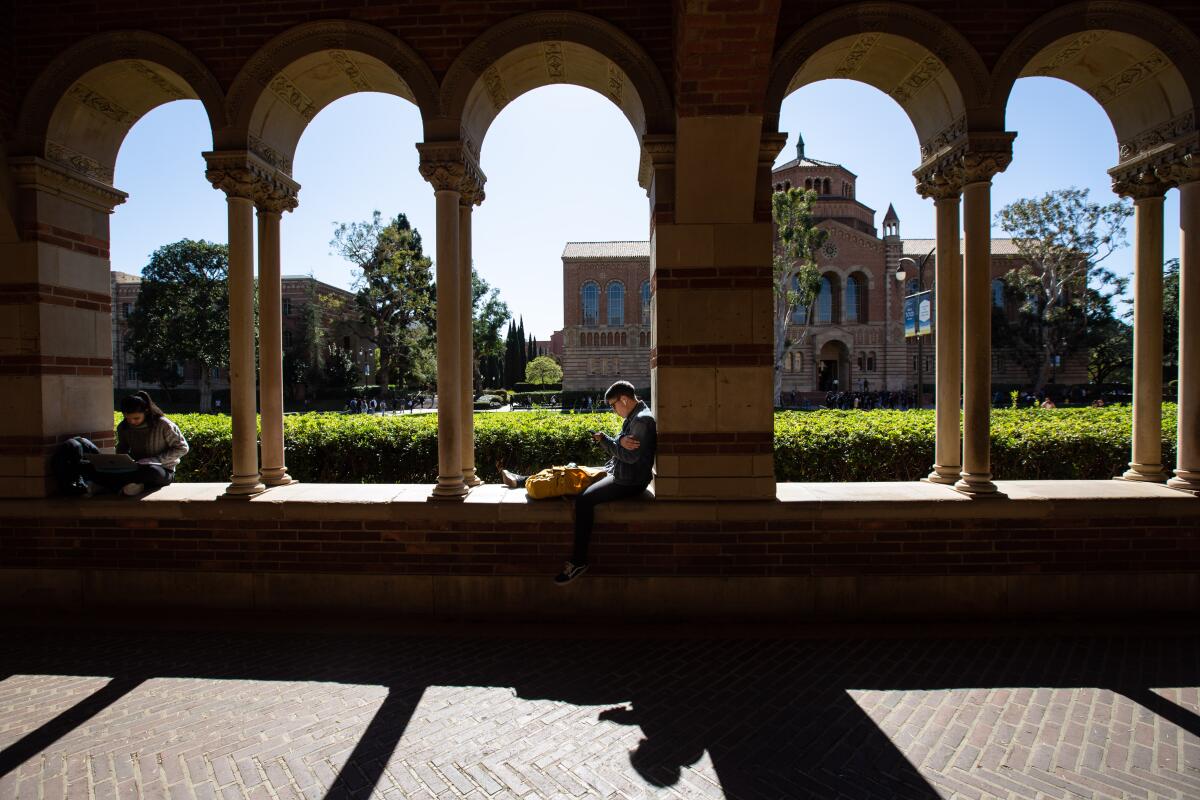UC smashes record for first-year fall applications, with gains in most racial groups

- Share via
For the second straight year, the University of California shattered records for first-year fall applications, as the elimination of standardized test requirements and greater online outreach paid dividends in drawing the largest and most diverse applicant pool ever despite pandemic challenges, according to preliminary data released Thursday.
But transfer applications fell at each of the nine undergraduate campuses — recording an overall drop of 12.6% systemwide — reflecting continuing declines in community college enrollment that have swept the nation and raised deep concerns about the well-being of students in the two-year system.
For the record:
7:32 p.m. Feb. 24, 2022An earlier version of this story, drawing from a UC statement, said the number of first-year applications grew 0.5%. UC later said the increase was 3.5%.
Overall, UC drew 210,840 first-year applications, a 3.5% increase over last year, with more students seeking admission from California, other states and other countries for fall 2022. Among them, California residents numbered 132,337, led again by Latinos at 38%, followed by Asian Americans at 31%, white students at 21%, Black applicants at 7%, American Indians at 1% and Pacific Islanders, less than 1%.
Black applicants have made particularly striking gains, increasing at the fastest pace among all racial groups. In the last two years, their numbers have grown by 25% systemwide with an even greater surge at the most competitive campuses, including 57% at UC Berkeley and 47% at UCLA. During that same time, Latino, Asian American and white applicants have increased by about 17%.
“The University of California remains an institution of choice for so many hardworking prospective undergraduates,” UC President Michael V. Drake said in a statement. “This diverse group of students has shown their commitment to pursuing higher education and we are thrilled they want to join us at UC.”
UCLA again drew the largest number of first-year fall applications in the UC system — making it the most sought-after university in the nation — with 149,779 students seeking seats. Among them, 91,544 were Californians — with 4 in 10 members of underrepresented minority groups or the first in their families to attend college. Nearly half were low-income students.
And UCLA applicants are more prepared than ever, with a 32% increase in the number of students who ranked in the top 9% of their high school class.
More applicants with higher academic achievement makes for tough competition, but UCLA plans to expand the number of seats for California residents this fall after cutting back last year, said Youlonda Copeland-Morgan, vice provost for enrollment management.
Gov. Gavin Newsom and state legislators are providing UCLA, UC Berkeley and UC San Diego funds to enroll about 900 more California students in place of nonresidents by covering the loss of the higher tuition paid by out-of-state and international students. Newsom’s proposed 2022-23 budget also includes funding for about 6,200 additional California students throughout the UC system this fall.
Copeland-Morgan said it was still unclear how many seats UCLA will add — last year it accepted 8,436 California first-year students among 84,182 applicants, a 10% admission rate. But an increase is certain this year, she said.
“While more applicants means there’s greater competition, we are still very excited ... about the fact that we will be able to offer admission to a larger number of students because our California target is higher,” she said. “We’re going to make a whole lot of more California students happy when they get those admit letters this spring.”
UC Berkeley led all campuses in growth, with first-year applicants increasing by 13.6% to 128,192. Among them, 72,417 were Californians, with about 4 in 10 students from low-income households, the first in their families to attend college or members of underrepresented minority groups.
“In a year where we saw application numbers across the nation decline, the entire UC saw increases,” Olufemi Ogundele, UC Berkeley’s associate vice chancellor of enrollment management and dean of undergraduate admissions, said in a statement. “Here at Berkeley, we saw even more of an increase than our peers. The diversity of our applicant pool continues to be strong, and we remain a top choice for incredibly talented scholars.”
But Berkeley is fighting a court order that would freeze enrollment at 2020-21 levels and force the campus to cut first-year and transfer student admission offers by about 5,100 and seats by 3,050. The UC Board of Regents has appealed to the California Supreme Court to stay that order while litigation over the environmental impact of Berkeley’s enrollment growth continues.
The competition for UC seats has Joshua Martinez, a senior at Venice High School, on edge. The high-achieving student, who is the son of immigrants from El Salvador and Honduras, has applied to seven of the nine UC undergraduate campuses to maximize his opportunities for admission.
His mother wants him close to home and is rooting for UCLA, he said, but he is eager to start his independent college life. His top choice is UC Santa Barbara, which he said offers a good package of distance from home, beach life and a quality program in his intended major of political science. His 4.2 GPA should make him competitive for Santa Barbara, but nervousness is his “No. 1 emotion now” as he awaits admission decisions next month.
“I think every senior, everyone in my friend group, wants to be three weeks ahead and know where we’ve been accepted,” Joshua said. “In a month, our dreams will be reached or crushed.”
UC’s second year of record-breaking applications ended a downward trend in 2019 and 2020, when demographic experts said a decline in college enrollments in the Northeast, reflecting falling birthrates and fewer high school graduates, could finally be hitting the West Coast.
UC admission leaders say that two developments appear to have changed that trajectory. First, the UC system eliminated SAT and ACT testing requirements in 2020, emboldening more students to apply. Then the pandemic forced campuses to turn to online recruiting, tours and information sessions — which allowed them to expand their reach across California, the nation and the world.
UC Irvine, for instance, has received first-year applications from 57 of California’s 58 counties, the broadest geographical representation ever.
Dale Leaman, UCI executive director of undergraduate admissions, said his campus recruiters might not have been able to get to a college fair in a rural region, for instance, putting Irvine at a disadvantage to local colleges or universities that could show up in person. But the shift to online recruiting reset the game, he said, especially for students who might never have heard of Irvine.
“A virtual environment, where even the local colleges are virtual, evens the playing field for everybody and we really were able to take advantage of that,” he said.
UC Irvine and UC San Diego both saw first-year applications increase by more than 10% over last year and drew the most Californians after UCLA. Irvine also had the largest number of California first-generation students and Asian American applicants. UCLA had the highest number of Latino and Black applicants, while UC Santa Barbara drew the most white students.
Transfer applications fell systemwide to 40,339 from 46,155 last year. Han Mi Yoon-Wu, UC executive director of undergraduate admissions, attributed the change to the overall decline in community college enrollments across the nation and said the university was working to strengthen support for transfer applicants and provide a “strong and diverse pipeline of students” to UC campuses.
The pandemic continued to affect applications, raising questions about how they will be reviewed. Leaman, at Irvine, said a larger number of applicants this year submitted transcripts with pass/no pass marks rather than letter grades. For transfer students, he said, that will affect the chance of admission for certain majors that require letter grades in specific courses. Biological sciences and business information management, for instance, require letter grades in science or math courses for admission.
At UC San Diego, pandemic challenges will inform the way reviewers assess applications, along with the 13 factors used in UC’s comprehensive review process.
“This year we would expect to include the impact of the pandemic on applicants — from access to technology for online learning to caring for family members, the challenge of maintaining extracurricular activities and everything in between,” said Jim Rawlins, associate vice chancellor for enrollment management.
More to Read
Sign up for Essential California
The most important California stories and recommendations in your inbox every morning.
You may occasionally receive promotional content from the Los Angeles Times.











